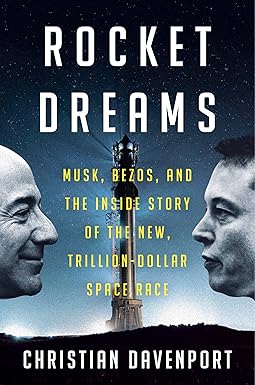Centauri Dreams
Imagining and Planning Interstellar Exploration
A Tantalizing Exomoon Possibility
Gravitational microlensing is a phenomenally interesting way to find unusual things in the cosmos. A closer star can bend space around itself enough that, when it passes between us and a more distant star, a distinct brightening of the distant star’s light is apparent, a lens effect. That’s a useful phenomenon in its own right, and gravitational lensing involving distant galaxies is a significant part of some astronomers’ toolkits. But we can also use the effect when looking for exoplanets, and in the case of recent work, even a candidate for an exoplanet’s moon.
The method works in this context because if the foreground star has a planet orbiting it, a second lensing event can occur, and a comparison between the two brightening events can help us figure out the relative mass of the two objects. The problem with microlensing is that these are one-shot events, dependent on chance celestial alignments. In other words, we can’t go back and study them a second time. That’s a shame, because some studies have found what appear to be free-floating planets, an interesting find we’d like to learn much more about.
Now we have MOA-2011-BLG-262, a microlensing observation made by the Japan-New Zealand-American Microlensing Observations in Astrophysics (MOA) and the Probing Lensing Anomalies NETwork (PLANET) programs, working with telescopes in New Zealand and Tasmania. The work shows two objects, one of them about 2000 times smaller than the other. We are looking at either a small star and a planet about eighteen times as massive as Earth around it, or else a planet larger than Jupiter orbited by a moon less massive than Earth.
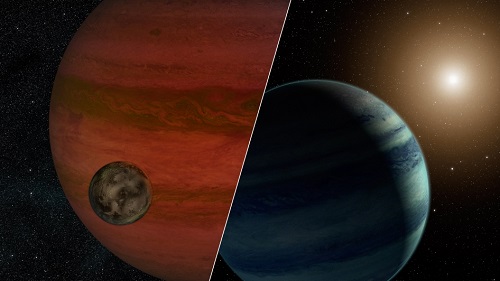
Image: Researchers have detected the first “exomoon” candidate — a moon orbiting a planet that lies outside our solar system. Using a technique called “microlensing,” they observed what could be either a moon and a planet — or a planet and a star. This artist’s conception depicts the two possibilities, with the planet/moon pairing on the left, and star/planet on the right. If the moon scenario is true, the moon would weigh less than Earth, and the planet would be more massive than Jupiter. Credit: NASA/JPL-Caltech.
The exomoon option seizes the attention because exomoons have yet to be detected, and pushing the limits of detectability down to this scale is a real achievement. But why the wide range between the two possibilities? The problem is that we don’t know how far away the two objects are. If they’re closer to the Earth, they’ll produce the same effect as a more massive pair — planet around star — would at a considerably larger distance. It’s possible to use parallax techniques, taking advantage not only of ground-based telescopes but of space assets like the Spitzer space telescope, but we don’t have that data for MOA-2011-BLG-262, which will remain a mystery.
Gravitational microlensing, then, gives us a sudden illumination of a distant stellar system, after which all hopes of future observations disappear. It’s like a sudden beam of light illuminating part of the cosmos whose effects disappear all too quickly, leaving us to ask questions like this one: If this is a rogue planet, and assuming it was ejected from a young planetary system by gravitational interactions there, how did it keep its moon, and how likely are such scenarios?
Meanwhile, we continue with the other methods in our arsenal, as highlighted, for example, by David Kipping’s Hunt for Exomoons with Kepler project, in hopes of answering questions about more conventional moons in actual solar systems. The paper is Bennett et al., “MOA-2011-BLG-262Lb: A Sub-Earth-Mass Moon Orbiting a Gas Giant Primary or a High Velocity Planetary System in the Galactic Bulge,” The Astrophysical Journal Vol. 785, No. 2 (2014), 155 (abstract).

ISEE-3: The Challenge of Long Duration Flight
Some mission concepts for interstellar flight demand equipment that can stay functional not just for decades but for centuries. Do we know how to build such things? Missions like Voyager are encouraging in that we have two spacecraft that were never built for the kind of longevity we’ve demanded of them, and we’re still tracking their signals. But as Robert Forward once speculated, the problem may not be just in building the spacecraft, but in how we handle them.
Forward’s issue involved the changes on Earth that might occur over a long-duration spaceflight like the one he envisioned in Rocheworld (1984, first published as Flight of the Dragonfly). A crewed starship is actually on the way to Barnard’s Star, dependent on the massive laser installations in the Solar System whose beam will allow it to decelerate (through ‘staging’ the sail) into the destination star system. But there is a movement afoot on Earth to shut down the beam, motivated by money, politics and the usual cast of miscreants. The technology, in other words, works, but the question is whether the humans behind it will make the right decision.
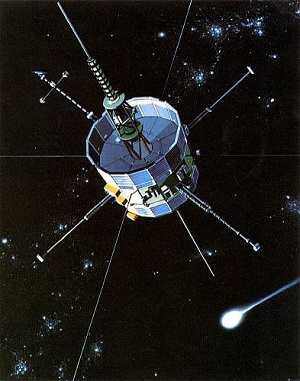
Much goes on in Rocheworld and the question of shutting down the laser is but a minor theme, but the question Forward raises is intriguing. Consider what’s happening with the International Sun-Earth Explorer-3 (ISEE-3), a spacecraft launched in 1978 to make observations of the solar wind’s interactions with Earth’s magnetosphere. Back in 1983, ISEE-3 turned into ICE, the International Cometary Explorer, and in that guise studied comet Giacobini-Zinner and later Halley’s comet. NASA even turned the craft loose after that to study coronal mass ejections before decommissioning the probe and closing down its systems.
This August, as the Planetary Society’s Emily Lakdawalla has noted, the spacecraft in its heliocentric orbit will be catching up with the Earth from behind, which creates an interesting issue of its own. Although officially out of service, ISEE-3 has been broadcasting a carrier signal that was detected in 2008. It’s also known that as of last check — this was some time in the 1990s — twelve of its thirteen instruments were still working. Could we get the 36-year old spacecraft back in service? It’s a compelling thought, but a tough task to accomplish.
Image: The ISEE-3/ICE spacecraft. Can it be returned to use? Credit: NASA.
The problem isn’t with the data from the spacecraft, which can be accessed by the Deep Space Network. The issue is our ability to talk to the probe. The Goddard Space Flight Center team responsible for the craft maintains a Facebook page, from which Lakdawalla quotes:
The transmitters of the Deep Space Network, the hardware to send signals out to the fleet of NASA spacecraft in deep space, no longer includes the equipment needed to talk to ISEE-3. These old-fashioned transmitters were removed in 1999. Could new transmitters be built? Yes, but it would be at a price no one is willing to spend. And we need to use the DSN because no other network of antennas in the US has the sensitivity to detect and transmit signals to the spacecraft at such a distance.
However, all hope is not lost. ISEE-3’s signal has been detected by the Allen Telescope Array as well as by radio amateurs, and scientists at the Applied Physics Laboratory are studying potential new, lower-power ways of contacting the probe, as Lakdawalla reports in a later update. If the craft’s engines can be commanded to fire, it could be recaptured into a halo orbit at the L1 Lagrangian point and returned to service. The odds are long and time is short — the engine firing needs to be accomplished no later than early June — but the fact that the APL team is actively working on this inspires me to keep an eye on the ISEE3returns Facebook page.
ISEE-3 is not, obviously, a manned mission, so the question of reactivating it has none of the life-or-death drama of the Forward novel. But it’s an interesting commentary on how our technology can sometimes expose our weaknesses. In this case, we have a functioning spacecraft that could conceivably come back into use, one that is for now rendered impotent until we can pull the resources together to use it. The cost factor speaks for itself, and it’s understandable. But I’m reminded of our problems reading old data from the Pioneer days because the equipment has become obsolete. Truly long-term thinking involves planning for changing formats and technological upgrades, a subject about which we’ll be learning much more as we contemplate deeper and longer missions into the dark between the stars.

Optimal Worldship Populations
Although we tend to focus on propulsion as the major obstacle to reaching another star, the biological problems that go along with journeys lasting decades or even centuries are equally daunting. If we could devise methods that would get us to Alpha Centauri within a century, we’d still face the need to keep a crew alive within a sustainable closed ecosystem for that amount of time. If we’re talking humans in starships, then, we need a lot more data about how people interact in isolated communities, stay healthy, and manage critical self-sustaining systems.
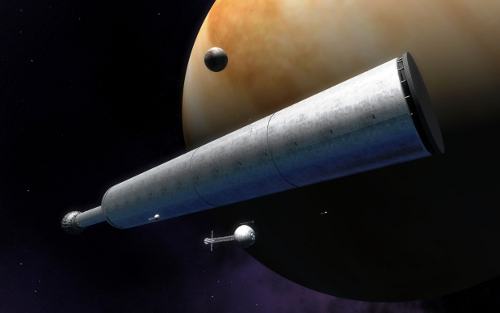
Image: A habitat for humans over generations, a worldship poses critical questions about survivability and genetic diversity. Credit: Adrian Mann.
Centauri Dreams readers will recall Cameron Smith’s interest in these matters, as reflected in his article Biological Evolution in Interstellar Human Migration, published here last March. The author of Emigrating Beyond Earth: Human Adaptation and Space Colonization (Springer, 2012), Dr. Smith (Portland State University) looks at these issues over the course of generations. How large does a starship crew have to be in order to keep the population healthy? This article in Popular Mechanics gives a nice overview of Smith’s findings, which were published in Acta Astronautica and flesh out his earlier essay in these pages. The work was performed as a contribution to Icarus Interstellar and its Project Hyperion.
Working with William Gardner-O’Kearney, Smith constructed simulations to create scenarios for interstellar travel with the help of MATLAB, a widely used tool for numerical computation. One immediate result was to draw into question earlier calculations by John Moore (University of Florida), who had found that a 2000 year voyage aboard a generation ship would require an initial crew of no more than 150. In sharp contrast, Smith found that a minimum of 10,000 was necessary, while 40,000 would be a safer number still given the perils of the journey. Starting population size, which the duo calculated over 30 generations, is a crucial matter.
A key issue, as you would expect, is genetic diversity. Small groups like the Amish and Ashkenazi Jews suffer higher rates of diseases like cystic fibrosis and Tay Sachs largely because of intermarriage between relatives. I’ll send you to the article for the bulk of the researchers’ graphs, but I’ll show one below, illustrating what happens within groups of different sizes over time. A ship starting out with a crew of 150 loses 80 percent of its genetic diversity after thirty generations. Even 500 is too small a number, for it does not represent a wide enough swath of the human population. Somewhere between 10,000 and 40,000 is where we find a starting population that can maintain 100 percent of its original genetic variation.
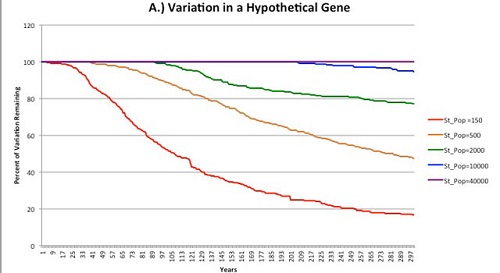
Image: The decline in genetic diversity among smaller populations over time is evident here. Note the 150 line in red at the bottom of the chart, with the most robust, in purple and representing a starting crew of 40,000, shown at the very top. This number maintains 100 percent diversity. Credit: Cameron Smith/Gardner O’Kearney.
Just as we preserve a healthy gene pool with a larger population, we also safeguard against external risks, the kind of catastrophe that could snuff out the entire population of a small ship. This work makes the case that housing tens of thousands of colonists in a single generation ship would be a mistake. Far better, when launching our expedition, to use multiple ships, traveling perhaps close enough together for trade and other human interactions, but separated so that a single disaster wouldn’t mean the end of the entire venture. I’m invariably reminded of the expedition led by Sky Haussmann in Alastair Reynolds’ novel Chasm City (2001), a fleet of starships that confronts a human-caused calamity.
10,000 seems to be the minimum number for success. Says Smith: “With 10,000, you can set off with good amount of human genetic diversity, survive even a bad disease sweep, and arrive in numbers, perhaps, and diversity sufficient to make a good go at Humanity 2.0.” That’s a large crew, but history has shown us that there are always pioneers, adventurers, misfits and any number of other psychological types willing to give up everything they have known to chance their future in unknown lands. The guess here is that if a fleet of five generation ships needing crews of 2000 each is ever built, it will not lack for volunteers.
The paper is Smith, “Estimation of a genetically viable population for multigenerational interstellar voyaging: Review and data for project Hyperion,” Acta Astronautica, Vol. 97 (2014), pp. 16-29 (abstract).

On the Enceladus Ocean
The recent news about an ocean on Enceladus had me thinking over the weekend about a trip my wife and I took years ago to Michigan’s Upper Peninsula. There we had rented a cabin for the week on the shores of Lake Superior, twenty miles from the nearest town, unless you counted the small grocery store, art gallery and scattered houses up the highway as a town — if so, it was a tiny one. Looking out across the silver and gunmetal gray waves of Superior, you could imagine it an ocean, a cold, frothing place of treacherous currents and, that October, raw winds.
Lake Superior appears as the comparison in many of the reports on the Enceladus findings as they sketch out what appears to be a sea just as large, perhaps ten kilometers deep covered by an ice shell four times as thick. Given that the well known plumes of Enceladus are already known to contain organic molecules in addition to salty water, the inevitable question arises: Could some form of life exist beneath this frozen surface? There’s no way to tell as yet, but the imperative to probe still further into the tiny world (504 kilometers in diameter) continues to grow.
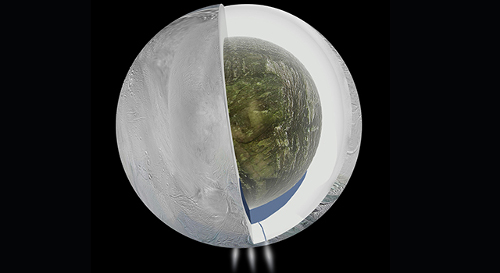
Image: This diagram illustrates the possible interior of Saturn’s moon Enceladus based on a gravity investigation by NASA’s Cassini spacecraft and NASA’s Deep Space Network, reported in April 2014. The gravity measurements suggest an ice outer shell and a low density, rocky core with a regional water ocean sandwiched in between at high southern latitudes. Views from Cassini’s imaging science subsystem were used to depict the surface geology of Enceladus and the plume of water jets gushing from fractures near the moon’s south pole. Credit: NASA/JPL-Caltech.
What we have in the latest work is the result of three Cassini flybys, two of them over the southern hemisphere, one over the north. The tiny deviation of the spacecraft from its trajectory — the velocity change was 0.2-0.3 millimetres per second — could be detected in Cassini’s radio signals, helping us measure variations in the gravity of the tiny world. The payoff is explained by Luciano Iess (Università La Sapienza, Rome), lead author of the paper in Science:
“By analysing the spacecraft’s motion in this way, and taking into account the topography of the moon we see with Cassini’s cameras, we are given a window into the internal structure of Enceladus. The perturbations in the spacecraft’s motion can be most simply explained by the moon having an asymmetric internal structure, such that an ice shell overlies liquid water at a depth of around 30-40 km in the southern hemisphere.”
These measurements are extraordinarily fine, but analysis of the Cassini signal can detect changes in velocity as small as 90 microns per second, according to this JPL news release. Although the southern polar region has a surface depression that affects the local pull of gravity, the magnitude of the gravitational dip is less than it ought to be given the size of the depression, which leads to the finding that a high density feature beneath the surface is the cause. Denser material, probably liquid water, compensates for the missing mass. This water may or may not be the source of the south pole plumes Cassini has observed in the past, but that possibility certainly exists.
Meanwhile, I’m recalling an earlier encounter with Enceladus. Freeman Dyson was talking about the moon as a target for the Orion spaceship in the late 1950s, and in a twelve-page report in 1958 called “Trips to Satellites of the Outer Planets,” he made the case for visiting the gas giant moons. Decades later, he would explain his thinking to his son George, as recounted in the latter’s Project Orion: The True Story of the Atomic Spaceship (Henry Holt, 2002):
“We knew very little about the satellites in those days. Enceladus looked particularly good. it was known to have a density of .618, so it clearly had to be made of ice plus hydrocarbons, really light things, which were what you need both for biology and for propellant, so you could imagine growing your vegetables there. Five-one-thousandths g on Enceladus is a very gentle gravity — just enough so that you won’t fall off.”
Amazing to recall that, at least for a time, the motto of Project Orion was “Saturn by 1970.” But it’s clear from everything we’ve learned about this moon since that Enceladus remains a primary object for study, even if we’ve now moved into the realm of astrobiology. What a surprise that would have been to the Orion team back in the 1950s!
The paper is Iess et al., “The gravity field and interior structure of Enceladus,” Science Vol. 344, No. 6179 (4 April 2014), pp. 78-80 (abstract).

Woven Light – Proteaa
Heath Rezabek is concerned with information — how we uncover it, how we use it, how we store it against cataclysmic events. A librarian and futurist, Heath uses science fiction to explore how Vessels of preserved knowledge might be developed and maintained not only on Earth but in the far reaches of our Solar System and beyond. In today’s work, he traces resource discovery and archival technologies back as far as Vannevar Bush and forward into a future that has transformed our early experiments into endlessly morphing realms of human growth and preservation.
by Heath Rezabek

This is the fourth installment in a continuing series of speculative fiction here on Centauri Dreams. Feedback from prior installments helps shape the themes and direction of subsequent entries, but the purpose and focus of these pieces is to explore a timeline (or timelines) in which comprehensive, resilient archives of Earth’s biological, scientific, and cultural record — deep archives for deep time — are developed through unexpected means.
Woven Light (I) – Vessel Haven https://centauri-dreams.org/?p=29669
Woven Light (II) – Adamantine https://centauri-dreams.org/?p=29897
Woven Light (III) – Augmented Dreamstate https://centauri-dreams.org/?p=30128
Woven Light (IV) – Proteaa
– – – –
Buckminster Fuller, in the process of designing and inventing a variety of structures based on geodesics, was at one point challenged by a patron to design a city which could float in Tokyo Bay. While this seems similar enough to the modern concept of seasteading, Fuller decided that the challenge was lacking in ambition. He instead developed a hypothetical framework for truly floating cities: Spherical structures which could drift above the surface of the Earth, configured internally however one wished.
Fuller believed such structures would not likely be built until pressures on Earth’s resources and settlement sustainability were much greater than they were at the time, and he somewhat whimsically called them Spherical Tensegrity Atmospheric Research Stations (STARS), or Cloud 9s. They were based upon the simple fact that if one enclosed a half mile (diameter) with a geodesic sphere, the structure itself would weigh but a thousandth of the weight of the internal air. Thus, if heated by a degree or more, the structure would lift and could become airborne.
Only glimpsed and hinted at here, we may see them again in future installments. As fantastical as they may seem, they bear a striking resemblance to an even more astounding thought experiment, also explored here.
Freeman Dyson, in his session for 2013’s Starship Century Symposium, proposed one of the most startling instances of a Vessel-like archive in my ongoing survey of such proposals: Called “Noah’s Ark Eggs” – I often refer to them as Dyson Eggs for short – their collections would be living biospheres, each self-contained and independent as a carrier of Earth-originating life to distances as far as you could wish, as randomly as you please. In this scenario, careful construction and glazing – aided by the engineering of viparious plants – would allow a Dyson Egg to contain enough heat to sustain a biome on starlight alone, as it drifted or was directed through the chilly reaches of space.
As living archive, each instance would develop by natural selection from a single-set in countless directions, ultimately carrying those finely honed living ingredients and blueprints to unknown worlds like dandelion wisps on the wind. This idea was mentioned in a prior Vessel Open Framework entry, discussing the possibility of individual habitats throughout the asteroid belt as a way to mitigate Xrisk.
If Dyson Eggs could be engineered for human (or transhuman, or posthuman) purposes as well as those of plant life, another unknown avenue for Earth-originating archives and civilization would open up. We also ask: if in space Dyson Eggs are possible, then are Fuller Spheres / STARS / Cloud 9s possible as well, above the surface of the Earth or elsewhere? If not as extended-purpose habitats, might our fictional version of Vessel Labs give them a try, for limited-population Vessel archives, in a timeline yet to be explored?
Although discussed most fully in the course of the narrative, one last design fiction is to be mentioned here as well, and that is Vannevar Bush’s Memex, as detailed in his 1945 Atlantic article, As We May Think. His original proposal has much more in common with nascent augmented intelligence than it does with what we now have at hand in our current digital networks; that original article is always worth a new look as we weigh our future aspirations against the technologies envisioned by our predecessors.
– – – – –
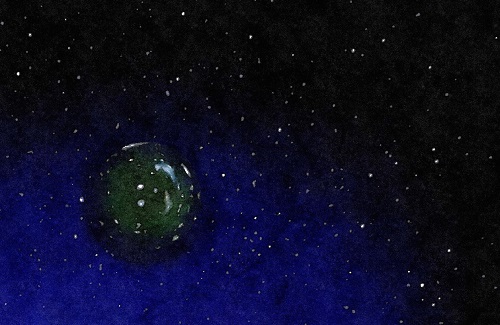
Image: ‘Precursorae’, Heath Rezabek. Adaptation of photography CC BY-SA Wikimedia.
Shimmering, barely a flicker against the wall of night, a slim circumference slides stars aside at its edges, falling through the space between.
Inside thrives a verdant darkling jungle, weightless and entangled. Structurally, its mass is a mesh of entwined greenery, countless conduits, endlessly connecting.
Its warmth is fed by the barest of starlight; its mission knows no fixed end.
Amidst the brambles, prowlers make their slow way from one kill to the next, as the smaller ones scurry between safer perches, instinctually, perpetually, all one in their motion.
At a glance, the apex is red in tooth and claw. But appearances can deceive, in light as lost as this shadowing. The true apex belongs to beings who’ve smoothed their subtler instincts until they’ve fused with logic and language alike. Were there a way for us to witness them, grappling and gliding between boughs, we would be excused for mistaking them as human. Yet human — strictly speaking — the Avaai are not.
The name is emergent and generative, like their language. It means, more or less, “Those who remain through departing.” They are, in some ways, our descendants; but in timeless reaches, their science reborn as generative myth, even they will come to be known as precursors. And they are few among many, splayed afield and bound far from their fellows by a gambit: a seed, a sphere, an impossible Aleph.
Of the many names given to these starborne terraria in the deeps of their time, Precursorae was one. Ark Ovae another. Dysonae, a third. They are adrift; but they are never alone.
The Avaai have two eyes and ears, yet they share thought with myriad nearby forms who have nothing of the sort. The Avaai have two legs and two arms, yet their movements are lithe and their forms are stretched by weightless dance. Their features are more angular, their aspect more severe; their thoughts a fog of mind shared with all around them. They are organic, but they are not, so to speak, biological. They are synthetic, but they are not, as it were, artificial. Like koans, like the Tao, they are better described through what they are not.
They are Proteaa, and like everything else here, they share a basis in Protean cells.
Like Protean cells themselves, the Avaai are transmortal, able to pass from one form into another, able to share their thoughts and lives with the flora and fauna all around them, with which they are inextricably bound.
The fog of mind is their medium; fluid sometimes, particulate at others. They craft artifacts, in which every atom carries an echo of the whole. They are solid state; yes, and liquid as well.
But one thing they do not know, collectively or alone, (for they can recede and retreat if they wish) is how long they have been, and how long they might be. The deep well of remembrance harbors a mythology which has mapped the slow drifting of their constellations into shapes entirely other than the ones they’d known before.
These ever changing all-surrounding starfields — the personae retraced upon them — are their mythemes, the most basic of forms. Formulae and hypotheses, a scattered suspension of salt in the waters. ~For matter is slumbering light~
Their inheritance is a deep-healing habit of retreat, where solitude and union cleave and renew. And when they look closely, turning inwards, they can gaze into a place that is also time. They can convene and converse with a dark mind made clear through its gravity, known to them as the Kainadhren, Ancient Light. And through its channels and conduits, they can quite nearly reach other times and far places. Quite nearly: pushing at that membrane which reflects all times and places, an infinity-etched horizon.
We would find life within a Protean Precursorae to be brief and delirious. But we can guess in some sense at the transmutable lives of the Avaai, because we were the ones who observed the emergence of the Proteaa. And together, we’ve run the simulations.
– – – – –
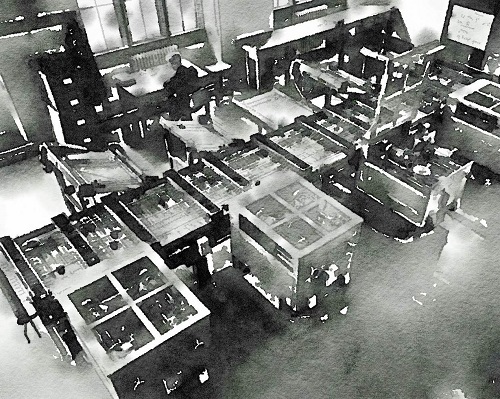
Image: Adaptation of ‘Vannevar Bush’ CC BY-SA Wikimedia.
Before Thea Ramer was a research scientist in holographic cartography, she was a writer of speculative fiction, part of a writing group with several instances around the world. As part of this club, she’d developed a series of writing exercises to banish forever the excuse of writer’s block. One of her inspirations in this had been a now-mythic proposal by a wartime scientist named Vannevar Bush, titled As We May Think.
Although history would see this work as having been a key inspiration in the development of her era’s still-capitalized Internet, the original proposal had much more to do with memory and association than it did with switching or even linking. His thought-experiment prototype, which he called aMemex, was to be a way for thinkers to track and trace the sinuous pathways of their own inspirations and memories, as they sparked and resparked one-another, clustering and growing over time.
For Vannevar Bush, tasked with assisting in the collective remembrance of a generation of scientists at work in dark days, this was a way for thinkers to organically archive and pass down their best associations and kernels of discovery. But Thea saw something different in the latent potential of Bush’s original model. “Writing is a way of thinking in traces,” she would say; and she had glimpsed a means for regenerating a primordial soup of ideas through association, whether done alone or as a game between players. And so a set of writing (which is thinking) exercises emerged.
The exercises could be used by anyone with a challenge to overcome; and indeed, she herself would apply these methods much later in her work on holographic syntax, which would eventually yield hologlyphs, which would come to find a home deep down in the living code of Protean cells.
At the time of her efforts on her speculative fiction, The Tracer Guild, her use of these tools were in full swing. Though it would be years before they were adapted for work on the Avatamsaka synthetic mind, already she’d called the resulting pool a Codex – partly in honor of the Memex, and partly from an understanding that before there were books, there were bundles bound by hand and over time. To Thea, a Codex was bound not by thread but by association, theme, subject, intent.
Any given project might have a codex built up around it, filled with its influences and fragments of its form. In this way, a codex became a kind of random access archive of materials and raw ingredients, in which orderly arrangement was much less important than withdrawing sets and samples in a way that sparked sensemaking. In its earliest forms, the Vessel Codex which would ultimately drive Avatamsaka’s pattern-sampling technique was initially a very manual approach.
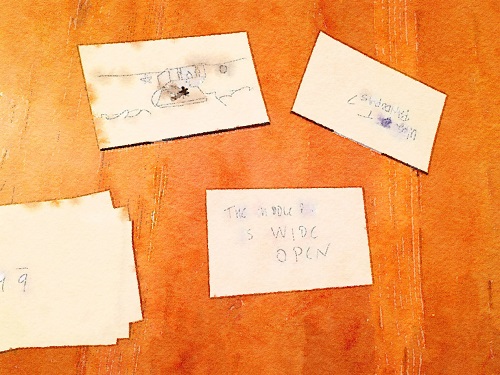
Image: ‘Wildcards.’ CC BY-SA Heath Rezabek.
Wildcards worked like this: You needed at least three players, each with a stack of blank index cards. The seeker (whose turn it was) would write on a blank (or draw if need be) something on their minds, on which they were seeking input. They’d lay it out, and the others would pen their response, based on what they knew of the seeker and the subject. The seeker would take stock, and pick the most useful response. They’d get to keep all the cards as payoff, and the turn would pass to the one with the favorite response, who’d get to be seeker in turn. The mechanic wasn’t perfect, and they were always tweaking it; but this was its basis.
Though it’d be tedious to detail the turns of their session here, it’s worth noting that this evening Thea walked away with five cards whose contents would come to influence her work more than she could have guessed.
[ Pathfinders ]
[ Shadow-forms gather around the core ]
[ The riverbed splits at a massive, ancient tree ]
[ Albino traders make the best maps of the deeps ]
[ These passages go on forever ]
[ Ancient Light ]
She, in turn, had supplied these responses to her friends:
[ White dwarf stars ]
[ Rebuilt every twenty years ]
[ That which does not expand forever, eventually contracts ]
[ Tales of the Kami ]
[ All their constellations would differ from ours ]
[ Calligraphy, Astronomy, and Swordsmithing ]
[ Perhaps the solution is not chemical but mathematical ]
[ Customs are a form of Etiquette ]
Home again, Thea shuffled these cards into file with uncounted others. She had once spent her time typing them into an aging, soon to be extinct digital platform called HyperCard, the clack-clacking of her Centris a kind of hypnosis; but she’d come to trust both the durability and even the labor-intensity of her pen-scratched cardstock.
Thea Ramer surveyed the card files as she slid the last one into unsorted slumber. “There, now. Dream awhile,” she muttered, and reached for her wine. She would not draw any of these particular cards out in a pattern-sample for months — in several cases, she’d never lay eyes on them again. Yet there they lay and waited; a glimpse now and again was enough to plant seeds deeply in the imagination…
– – – – –
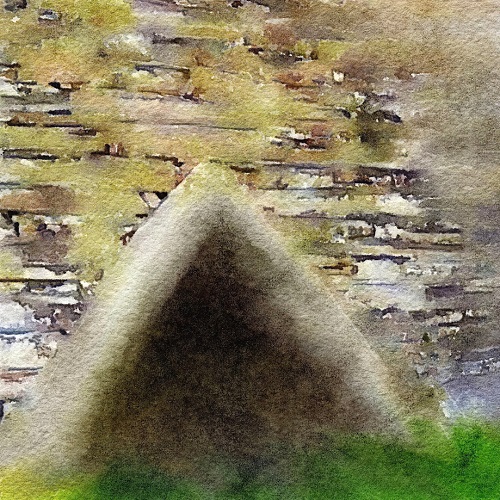
Image: Adaptation of photography CC BY-SA Wikimedia.
Dr. Kaasura stood, faltering in the low light of the cavern. Before him lay the crates, one — the white one he’d carried from the flooding road, splayed open, leaning on stone. He reached out, pulling it to rest level at his feet. The crate’s white material was dense, with a feel almost like sanded wood. Its matte sides, unscarred by the storm or his trials, reflected nothing of the cavern’s aqua glow. Jota wiped a stray leaf away, small bits of mangled fern sticking to his fingers.
Inside it was a very cubic looking box, quite black, also matte, and so featureless that, at this angle, it seemed to Jota’s eyes a dark hexagon, a gap in space, no edges to be seen.
A flicker skimmed the white inner surface of the crate. Kaasura walked closer, looking at the side wall, and found it lit with tiny squares of different hues. “Projections?” he muttered, looking back at the surface of the inner box. Pitch black, no signs of life. But another look at the projections was enough to resolve them clearly.
Arrayed against the white insides, countless little pinholes, neither square nor round, all different, faded in and out. Bringing his focus to bear on a small spot, Jota Kaasura could see a sea of impressions shimmer and fade: an iron teapot, or the image of one. His aunt, in a scene he could not recognize. Beside her, in another tiny scene, a small child bounced a ball, running in some game. A ruined landscape, scarred by a massive red orb, feral and fading… An apple; an overturned wheelbarrow; sunrise over a stormy sea. A slipstream sail gliding through depthless night.
Kaasura stumbled back, awestruck at the sight. Countless images, faded in and out as if clouds were passing in front of stars. He turned to face the wooden crate, then, as if to forget the black in white. It too looked identical to the one overturned by the truck, but its sides were dry, unmuddied, unbruised. Jota looked at the edges, and found them nailed shut. His fingers felt at his pockets, expecting the pocketknife they found there. He started prying at the lid, unsurprised when it released so easily from the crate. Unsurprised, but not untroubled.
Inside, old packing strips, shredded and brown; and nestled within – a kind of a globe. Several feet across, each tiny pane in its varied surface was triangular, miniature, geodesic. The glass was gritty, each edge a wiry seam. Jota braced himself to lift it — and failed. It was cold to the touch, even to his cold fingers.
Dr. Kaasura stood and sighed, turning to the metal crate. It seemed to have three latches, each with its own lock and perhaps with its own key. He was suddenly very tired.
“Who are you?”
Kaasura turned with a start. A woman stood in the far corner of the cavern, a staff turned towards him. He couldn’t make out her face, but she was short and her stance was strong. Jota held out one hand, open-palmed…
“Why are you here? How did you get here?” She took a half-step forwards, the end of her staff alight with countless fibres. Electrified?
He held up his other hand, nodding. “My name is Jota. I came here to shelter from the storm.” He gestured back to slick rockface behind him, the subsiding rains down below. “I… certainly didn’t expect to find anyone else here…”
She frowned at his nudge for information, hesitating before motioning towards the rear of the cavern. “I live here. Not here,” she motioned at the dim room around them, “back there; our skycity’s docked.”
She looked around then, almost nervously, as Kaasura considered what to say. She interrupted before he could.
“You can’t be here.”
“Why not?”
“It’s just not allowed. You have to be escorted.”
“Well, surely you could escort me, couldn’t you?”
“I don’t know you. I don’t know where you came from, or what your intent is, here.” She was on the edge of helping him; he could feel that much. He raised his hands higher, his arms wider, gesturing towards these ends.
“I only meant to shelter from the storm. I was fleeing for my life — well, that and… I was trying to save these crates.” He motioned, then, at the three mysteries tumbled on the floor.
She looked down at them, a worried look on her face. When she glimpsed the geodesic sphere in its shredded bed, she stopped short and her look turned strangely. “Where did you get that..?”
Eyes fixed upon the geodesic sphere, he watched her as he hesitated. She made her way towards the black box in its white crate. “What are they?”
“I’m not sure,” Kaasura said truly. “And without my laboratory, it’s hard for me to find out. I need a place to rest, and to work.”
She looked at him, long and low, weighing her factors.
“What is your name. I’m Jota. You..?”
Hesitation. Concern.
“… Call me Miira.”
He tried it: “Mirra?”
She shook her head, no longer so stern. “M i i r a”.
“Miira.”
She nodded — “Wait here.” — and turned.
A few steps towards a dark way he hadn’t seen, she paused. “That is, you’re free to go. Back the way you came. But don’t try to come after, until I return.”
Then in shadows, she was gone.
Jota blinked, hands still outstretched, the room suddenly vast in its silence. He walked towards the corner into which she’d disappeared, his eyes adjusting to the dim aquamarine light. Although there are fewer of the cracks he’d noticed on his way up the channel, he could still make out a few slim rivulets of mossy luminescence spreading out and down a smoothly carved tunnel, as if in glacial pursuit of Miira’s faded footfalls.
He stopped and examined the doorframe. Although the room of the cavern was roughly hewn, as if by nature and effort, at the rear a triangular bracing cut the wall, thick and apparently metal. The cavern that cut forth from there carried its angular lines, but split and bifurcated as it sliced through the stone.
He looked at the stone, then, as if for the first time. Pumice? Tiny dark cells in a petrified foam. He was exhausted.
Kaasura stepped backwards, once; twice; turning, he found support on the white crate, collapsing to the floor beside it, still soggy and cold.
Leaning his head against its sides, Jota sat facing the triangular passageway. He could hear dripping throughout the cavern, and far behind, the slow washing of sea and storm subsiding.
Echoes and stones, falling far in the distance, down the maze of twisty passages, along the way which Mirra had made her way, along the way…
And he begins to nod.
And he begins to dream.
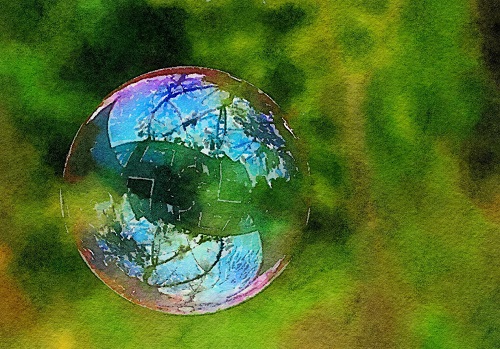
Image: Adaptation of ‘Reflection in a Soap Bubble.’ CC BY-SA Wikimedia.
And in the dream, Kaasura sees a bubble, adrift, floating high above the land. At first he thinks it’s a blown bubble, blown out over grass or a field. Its bright surface mirrors sharply the sky.
As he looks more closely, he can see features. The surface of bubble is riddled with layers and lines and portals and intaglio. There’s a texture to it, not quite consistent, but definitely patterned; definitely there.
Gigantic and ponderous, it drifts over the shoreline. He senses the scale, because far below he can see the ruins of the power plant. Smoke is rising from one of the crumpled generators. Steam billows as superheated runoff collides with the sea.
The sphere sails on, over the tips and tops of the mountain range (he can make out the cleft he climbed into) and on past the mountains. He follows as if in flight far above, freely falling through its wake. Below, mountain peaks cut coldly, impassably. It passes and passes them by.
The sphere reaches a wide open plain. As it opens up over that expanse, he can see that it’s a desert, cold and worn, under a ruddy sky. The ground has the strangest textures. Ancient and empty, crumpled and swept. Nothing breaks the surface of frozen red rock and rubble.
But in the distance, beyond the bubble by a far misty mile, he sees another. And then another; and he realizes that they’re getting smaller, as he rises higher.
More appear as they cluster and shrink beneath his altitude; they’re not near each other, but all of them drift as if part of the same current, eddying in waves as wide as landscapes, buoys and beacons on a sea of risen air. Signal lights flicker on their edges; warmer lights waver in their hearts.
And as Dr. Kaasura rises also, he begins to see an arcing curve to the land which lifts those bubbles, until they seem as if they’re afloat upon the surface of a bubble that’s far larger. And just as he feels the fragility can’t hold, he awakes — and finds he’s no longer in a cavern.
He takes a breath, and rubs his eyes. And far above his resting head, a skydome is traced, a prismatic array.

Small Payloads to the Stars
Making things smaller seems more and more to be a key to feasibility for long-haul spaceflight. Recently I went through solar sail ideas from the 1950s as the concept made its way into the scientific journals after an interesting debut to the public in Astounding Science Fiction. We also discussed Sundiver missions taking advantage of a huge ‘slingshot’ effect as a sail skims the photosphere. These could yield high speeds if we can solve the materials problem, but the other issue is making the payload light enough to get maximum benefit from the maneuver.
It puzzles me that in an age of rapid miniaturization and increasing interest in the technologies of the very small, we tend to be locked into an older paradigm for starships, that they must be enormous structures to maintain a crew and carry out their scientific mission. Alan Mole’s recent paper reminds us of an alternative flow of work beginning in the 1980s that suggests a far more creative approach. If we’re going to extrapolate, as we must when talking about actual starships, let’s see where nanotech takes us in the next fifty years and start thinking about propulsion in terms of moving what could be a very small payload instead of a behemoth.
I think sails connect beautifully with this kind of thinking. Mole envisions a sail driven by a particle beam, with the beam generator in Earth orbit fed by ground-based power installations, but we continue to look at other sail concepts as well, including laser and microwave beaming to ultralight sails made of beryllium or extremely light metamaterials. Payload-inefficient rockets don’t scale nearly as well to the kind of interstellar missions we are thinking about, but sails leave the propellant behind to enable fast missions delivering extremely small payloads.
This kind of thinking was already becoming apparent as early sail work emerged in the hands of Konstantin Tsiolkovsky, Fridrickh Tsander and others, and I’ll point you back to From Cosmism to the Znamya Experiments for more on that. For now, though, have a look at the marvelous Frank Tinsley illustration below. Here’s a startlingly early version (1959!) of sails in action, painted before Cordwainer Smith’s “The Lady Who Sailed the Soul” and Arthur C. Clarke’s “Sunjammer” ever hit the magazines. When Robert Forward began working on laser-pushed lightsails, he would have had images like this from popular culture to entice him.
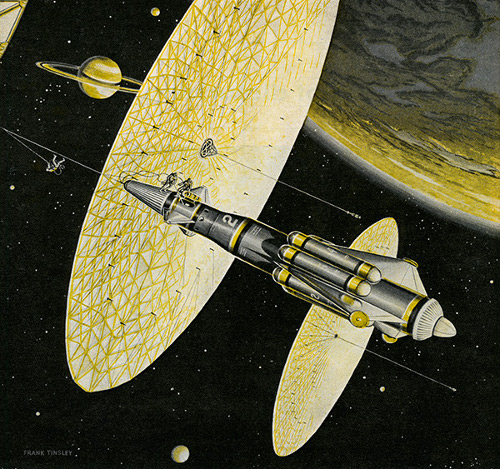
Image: An early look at the solar sail from a 1959 advertising image by Frank Tinsley. Credit & copyright: GraphicaArtis/Corbis.
Tinsley’s career is worth lingering on. A freelance illustrator known for his cover paintings for pulp magazines, he covered a wide range of subjects in magazines like Action Stories, Air Trails, Sky Birds and Western Story, with a stint in the early silent film industry in New York City in the 1920s, where he served as a scenic artist and became friends with William Randolph Hearst. By the 1950’s, he was illustrating articles for Mechanix Illustrated. A representative sample of the latter work can be seen here, packed with speculations about futuristic technologies.
But back to sails carrying small and innovative payloads. In a 1998 paper in the Journal of the British Interplanetary Society, Anders Hansson, who had two years earlier described what he called ‘living spacecraft’ in the same journal, reported on NASA Ames work into spacecraft consisting of only a few million atoms each. The study speculated that craft of this size would travel not as single probes but as a swarm that could, upon arrival at a destination system, link together to form a larger spacecraft for exploration and investigation.
Gregory Matloff, who along with Eugene Mallove wrote the seminal paper “Solar Sail Starships: The Clipper Ships of the Galaxy” for JBIS in 1981, has recently discussed the design advantages of solar sail nano-cables that would be much stronger than diamond. Nanotechnology in one form or another could thus influence the design even of the large sail structures themselves, not to mention the advantages of shrinking the instruments they deliver to the target. We may one day test out these ideas through nanotech deployed to asteroids to harvest resources there, teaching us lessons we’ll later apply to payloads that assemble research stations or even colonies upon arrival.
The Hansson paper is “From Microsystems to Nanosystems,” JBIS 51 (1998), 123-126. Greg Matloff’s 1981 paper with Eugene Mallove is “Solar Sail Starships: The Clipper Ships of the Galaxy,” JBIS 34 (1981), 371-380.

